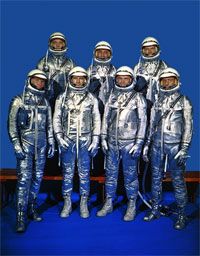Astronaut Recruitment
Today, the process for recruiting astronauts is streamlined and efficient. But when NASA set out to recruit the very first astronauts in 1958, it was entering unknown territory. One of the big problems had to do with defining an astronaut's role. In early job descriptions, astronauts were nothing more than observers who would view and document what was happening. It quickly became apparent, however, that human interaction would be required. Based on this, NASA decided it needed military pilots.
This was a logical decision considering the U.S. military's involvement with missiles and rocket planes in the aftermath of World War II. In 1946, the U.S. Army Air Force (as it was then known) and the National Advisory Committee for Aeronautics (NACA, the forerunner of NASA) placed an order with Bell Aircraft to produce three rocket planes. Eventually, testing of these aircraft was turned over to the U.S. Air Force, which had become a separate branch of the military as part of the National Security Act of 1947. On Oct. 14, 1947, Chuck Yeager
Advertisement
, an Air Force test pilot, broke the sound barrier in an X-1 rocket plane flying over Victorville, Calif. Although Yeager himself didn't become part of the Mercury manned spaceflight program, he served as a prototype for the kind of person NASA felt could succeed as an astronaut.
By the end of 1958, NASA finally settled on a list of qualifications for astronauts in the Mercury program. Each candidate had to:
- Be in a branch of the military
- Be younger than 40 years old
- Be shorter than 5 feet, 11 inches (180.3 centimeters)
- Hold a bachelor's degree or equivalent in engineering
- Be a graduate of a test pilot school
- Have at least 1,500 hours of flying time
NASA's astronaut selection committee sifted through the records of 508 servicemen throughout January 1959. About 100 of these were contacted for interviews and written tests, and 32 emerged as final candidates. A battery of medical testing cut the group to 18 and, finally, seven were chosen as the first astronauts. Three were from the Navy, three from the Air Force, and one from the Marines. The group became known as the "Original Seven" or the "Mercury 7" and included:
- M. Scott Carpenter (Navy lieutenant)
- L. Gordon Cooper Jr. (Air Force captain)
- John Glenn Jr. (Marine lieutenant)
- Virgil "Gus" Grissom (Air Force captain)
- Walter Schirra Jr. (Navy lieutenant commander)
- Alan Shepard Jr. (Navy lieutenant commander)
- Donald "Deke" Slayton (Air Force captain)
The Soviet Union began a similar selection process in August 1959 for its first group of cosmonauts. The Soviet Space Agency also turned to jet pilots as a source of candidates, and selection teams visited air bases throughout the country. A field of approximately 3,000 interviewees was narrowed down to 102 potential cosmonauts, who endured extensive and sometimes harrowing tests. By May 1960, with its training facility at Star City complete, the Soviet Union announced its first group of cosmonauts:
- Yuri Gagarin
- Anatoly Kartashov*
- Andrian Nikolayev
- Pavel Popovich
- Gherman Titov
- Valentin Varlamov*
*Eventually replaced by Valery Bykovsky and Grigori Nelyubov
As NASA learned more about what it means to be an astronaut, its requirements began to change. Learn more about today's recruiting guidelines on the next page.
